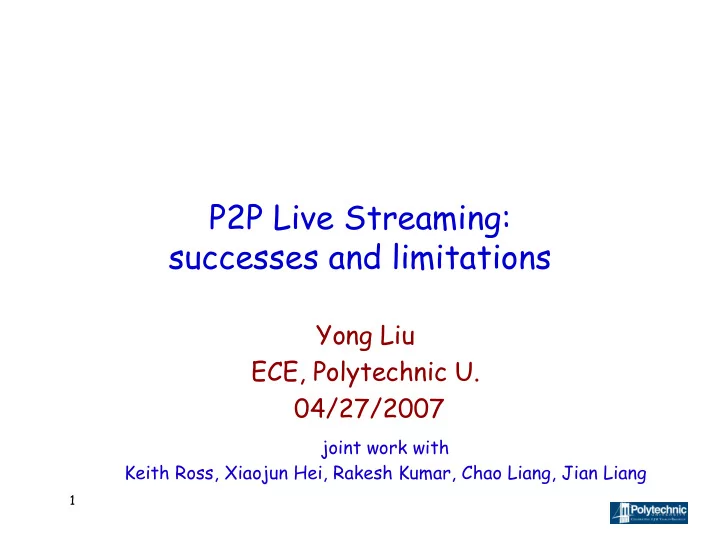

P2P Live Streaming: successes and limitations Yong Liu ECE, Polytechnic U. 04/27/2007 joint work with Keith Ross, Xiaojun Hei, Rakesh Kumar, Chao Liang, Jian Liang 1
Next Disruptive Application? Broadband Residential Access Cable/DSL/Fiber to Home BitTorrent, Skype Need for Video-over-IP youtube, “video blog” • 45 Tera-bytes video, 1.73 billion views -> 1.6billion $ video conferencing IPTV • live streaming v.s. video-on-demand • CNN breaking news v.s. broadcast World of Warcraft Impact on Access/Backbone networks 2
Possible Architectures Native IP Multicast (future Internet?) Content Distribution Networks (Youtube) Peer-to-Peer Streaming exploit peer uploading/buffering capacity, low cost Push, tree-based designs • e.g., end-system multicast from CMU Pull, meshed-based designs • inspired by BitTorrent file sharing • but with live streaming • Coolstreaming, PPLive, PPStream, UUSee, …… 3
P2P Streaming Success Stories Coolstream: 4,000 simultaneous users in 2003 PPLive: 200,000+ users at 400-800 kbps for 4-hours event, 2006 Chinese New Year, aggregate rate of 100 Gbps 400+ channels up to now • news, sports, movies, games, special events … 4
PPLive Overview Free p2p streaming software windows platform, proprietary Oct. 3, 2006 out of a Univ., China, commercialized popular in Chinese communities since 2005 400+ channels, 300K+ users daily Video encoded in WMV, RMVB, 300~800kbps http://www.pplive.com/ 5
How PPLive works peer2 peer3 Signaling not encrypted, peer0 protocol analysis through passive sniffing peers BT-Like chunk-driven P2P Streaming channels register with index server download/upload video chunks from/to peers watching the same channel (TCP) pplive peer1 servers stream buffered video content channel peer video list list source locally to ordinary media players 6
Macro-Stat.: user load 8pm-1am Weekend Weekend China weekly trend diurnal trend stable 8pm EST, US flash crowd scalable geo. distr. 8pm, China 7
Video Playback Quality indirect/unscientific measures subjective feedbacks from users stability of user population (more patient if free?) more peers, shorter delay, fewer freezing, faster recovery direct/quantitative measures: start-up delay: 10sec.-3min, “pseudo-realtime” buffer size: 10-30MB playback monitor on local peers buffer map analysis for remote peers 8
Challenges Bandwidth intensive incentives for redistribution: tit-for-tat? stresses on ISPs Asymmetric residential access cable, DSL: upload < download heavily relying on super-peers, e.g., campus nodes Peer churn: peers come and go video playback continuity Lags among viewers a neighbor cheering for a soccer goal 30 sec.s before you? 9
Theory Goal: Expose fundamental characteristics and limitations of P2P streaming systems Churnless model (deterministic) Churn model 10
Churnless Model Video rate: r d 2 d 1 u 1 u 2 u s u n Abundant Bandwidth d n No Multicast 11
Maximum video rate r max ? universal streaming: all peers receive at same rate r u � (rate of fresh content from server) max s r d (cannot overwhelm slowest peer) � max min n u u s � = + i r i 1 � (b.w. demand ≤ b.w. supply) max n n u u � = + s i r min{ u , d , i 1 } = ? max s min n Theorem: there exists a perfect scheduling among peers such that all peers’ uploading bandwidth can be employed to achieve the maximum streaming rate 12
Perfect Scheduling To fully utilize peers’ uploading capacity Peers with better access upload more u 1 =2 u 1 =2 d 1 =5 d 1 =5 r max =3 r max =4 u s =3 u s =5 u 2 =1 u 2 =1 d 2 =5 d 2 =5 For any peer b.w. dist., two-hop streaming relay achieves maximum rate 13
Imperfect Internet bandwidth sharing among applications on same computer among users in same access congested bottle-neck inside core? imperfect b.w. info. rate variations on sessions peer churn peers come and go against static scheduling (tree based) temporary deficits in uploading capacity impact of peer churn, solutions? infrastructural servers peer buffers 14
Peer Churn Model Two peer classes: type 1 ordinary: residential access type 2 super: campus/corporate access Upload rate for class i: u i u 2 ≤ r ≤ u 1 Arrival rate for class i: η i Average viewing time: 1/ μ i Li = # of type i, (random variable), ρ i = E[L i ]= η i / μ i P(“universal streaming”) = P(L 1 ≥ cL 2 – u’) 15
Large System Analysis Let ρ 1 and ρ 2 approach ∞ But ratio ρ 1 / ρ 2 = K More generally Theorem: In limit, P(“univ streaming”) = { 1 if K>c 0 if K<c - � if K=c = K � � + � � F( ) 1 2 2 2 c c + 16
Infrastructure: small system Infrastructural bandwidth improves system performance 17
Infrastructure: large system Infrastructural bandwidth must grow with system size 18
Buffering Peer churn causes fluctuations in a peer’s download rate (from server and/or peers): u u L ( t ) u L ( t ) + + ( t ) min{ u , s 1 1 2 2 } � = s L ( t ) L ( t ) + 1 2 Traditional streaming problem: bandwidth/delay fluctuations on client-server connections solution: content buffering, delayed playback Pseudo-P2P-Live-Streaming peers buffer d secs before playback always download unfetched content at I(t) from server/peers skip content more than d secs old 19
Buffer Simulation: small system Buffering improves performance dramatically. 20
Buffer Simulation: large system More improvement for large systems 21
Lessons Learned Peer churn causes fluctuations in available bandwidth “old days”: network congestion if too many downloading clients “p2p systems”: bandwidth deficits if too few uploading peers Performance is largely determined by critical value Large systems have better performance Buffering can dramatically improve things Under-capacity region needs to be addressed add more infrastructure apply admission control and block ordinary peers use scalable coding: • adapt transmission rate to available bandwidth • give lower rate to ordinary peers 22
Thanks! 23
Recommend
More recommend